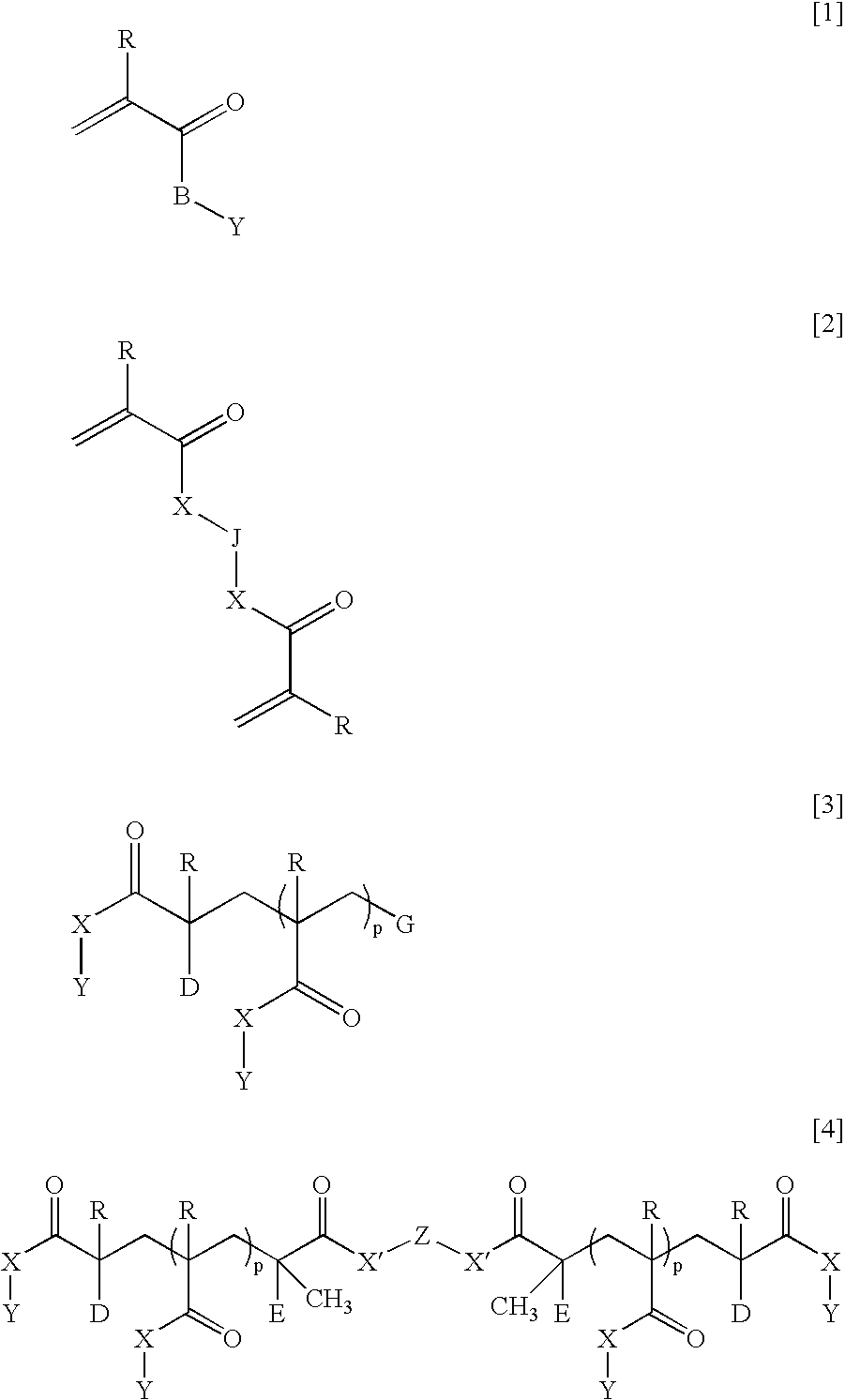Ophthalmic and otorhinolaryngological device materials
- Summary
- Abstract
- Description
- Claims
- Application Information
AI Technical Summary
Benefits of technology
Problems solved by technology
Method used
Image
Examples
example 1
Synthesis of hydroxyl terminated poly(2-phenylethyl methacrylate)
[0082] All synthetic manipulations were performed in a N2-filled glove-box. A Schlenk tube containing a PTFE-coated magnetic stirring bar was charged with 0.3340 g (3.374 mmol) of CuCl, 1.9665 g (11.09 mmol) of N,N,N′,N′,N″-pentamethyldiethylenetriamine, 30.9268 g (162.57 mmol) of 2-phenylethyl methacrylate (PEMA), and 30 mL of anisole. The flask was warmed to 50° C. in an oil bath and 0.4296 g (2.036 mmol) of 2-hydroxyethyl-2-bromoisobutyrate was added. The reaction was maintained at 50° C. for 3 hrs then cooled to room temperature. The product was diluted with ethyl acetate and purified by column chromatography. The product was further purified by precipitation from acetone into a large excess of methanol at 0° C. The product was isolated by vacuum filtration and rinsed thoroughly with chilled methanol, then dried under vacuum at ambient temperature and resulted in 20.5920 g (67%) of a white solid. The molecular wei...
example 2
Synthesis of methacrylate terminated poly(2-phenylethyl methacrylate)macromer [3]
[0083] An oven dried Schlenk tube containing a PTFE-coated magnetic stirring bar was flushed with N2 and charged with 20.3434 g (0.97 mmol hydroxyl groups based on GPC Mn) of Mn 21,273 hydroxyl terminated poly(PEMA). Anhydrous dichloromethane (50 mL) was added and the polymer was allowed to dissolve. Triethylamine (0.30 mL, 2.15 mmol) was then added. The flask was immersed in an ice bath and methacryloyl chloride (0.15 mL, 1.55 mmol) was added dropwise with stirring. The ice bath was removed and the reaction was maintained at ambient temperature for 7 days under N2. The mixture was concentrated on a rotary evaporator and the crude polymer was chromatographed on silica gel column with dichloromethane mobile phase. The eluent was concentrated using a rotary evaporator and the polymer was isolated by precipitation into cold methanol. The product was isolated by vacuum filtration, rinsed thoroughly with met...
example 3
Synthesis of hydroxyl terminated poly(2-phenylethyl acrylate).
[0084] All synthetic manipulations were performed in a N2-filled glove-box. A Schlenk tube containing a PTFE-coated magnetic stirring bar was charged with 0.2438 g (1.700 mmol) of CuBr, 0.6713 g (3.786 mmol) of N,N,N′,N′,N″-pentamethyldiethylenetriamine, and 7.0941 g (40.26 mmol) of 2-phenylethyl acrylate (PEA). The flask was placed in a 50° C. in an oil bath and 0.2840 g (1.346 mmol) of 2-hydroxyethyl-2-bromoisobutyrate was added. The reaction was maintained at 50° C. for 2 hrs then cooled to room temperature. The product was diluted with tetrahydrofuran and purified by column chromatography. The product was further purified by precipitation from dichloromethane into a large excess of methanol at −50° C. The product was isolated by cold vacuum filtration and rinsed thoroughly with chilled methanol, then dried under vacuum at ambient temperature and resulted in 4.761 g (67%) of a slightly yellow viscous liquid. The molec...
PUM
| Property | Measurement | Unit |
|---|---|---|
| Fraction | aaaaa | aaaaa |
| Fraction | aaaaa | aaaaa |
| Fraction | aaaaa | aaaaa |
Abstract
Description
Claims
Application Information
 Login to View More
Login to View More - R&D
- Intellectual Property
- Life Sciences
- Materials
- Tech Scout
- Unparalleled Data Quality
- Higher Quality Content
- 60% Fewer Hallucinations
Browse by: Latest US Patents, China's latest patents, Technical Efficacy Thesaurus, Application Domain, Technology Topic, Popular Technical Reports.
© 2025 PatSnap. All rights reserved.Legal|Privacy policy|Modern Slavery Act Transparency Statement|Sitemap|About US| Contact US: help@patsnap.com



